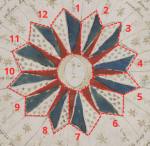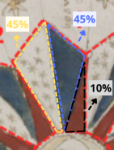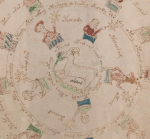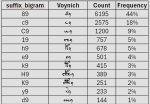| Welcome, Guest |
You have to register before you can post on our site.
|
|
|
| ? Practical Guide: How to Understand the Voynich Manuscript (The Operational Key) |
|
Posted by: JoaquinJulc2025 - Today, 02:49 AM - Forum: ChatGPTrash
- No Replies
|
 |
The Voynich Manuscript is an Alchemical Laboratory Manual encoded with a precise syntactical code. To understand it, you must stop looking for letters and start looking for operational commands.
1. The Paradigm Shift: From Language to System
Old (Failed) ParadigmNew (Operational) ParadigmThe text is an unknown language or a simple cipher.The text is a syntactic code of imperative commands (Tuscan style).Words are sounds or names.Words are sequences of action and state (e.g., qo-kedy = 'Prepare the kedy ingredient').Images are mystical illustrations.Images are flow diagrams and laboratory apparatus (distilleries, containers).
2. The Reading Key: The Functional Alphabet
To understand a line of Voynich text, you must segment it by the command prefixes. These are the "verbs" of the recipe:
PrefixFunction (The 'What to Do')Energy State
qo-
Preparation/Addition (Add the ingredient, adjust quality).Low (Cold)
chor-
Activation/Heat (Apply high energy or fire).High (Hot)
shol-
Stabilization/Cold (Cool, condense, or purify).Low (Cold)
ss-
Repetition/Control (Recirculate the matter).Control
chy
Result (Marks the final substance or elixir).Final
. The Structure (The 'Where You Are')
The manuscript is understood on two scales:
A. Macro Scale: The Master Route (Folio 86v)
- Function: This 9-rosette diagram is the conceptual map of the alchemical process. It tells you which phase of the Great Work you are in.
- Flow: The process must follow the Lead --- Gold equence, passing through alternating states of heat (chor-) and cold (shold-)
- Control: If the recipe fails, you must return to the Salt (Center) node, identified with the ss-
(Repeat) command, to begin a new purification cycle.
B. Micro Scale: The Pharmaceutical Recipe
- Function: The texts in this section are the detailed instructions for each step of the Master Route.
- Reading: The lines of text are rhythmic sequences of commands. For example:
qo-kedy chor-fal shol-daiin
Translation: "Prepare the ingredient, activate high heat, follow with cooling."
4. Conclusion: The Final Purpose
To understand the Voynich, you must accept it as an Encrypted Technical Manual. Every illustration and every line of text contributes to a single goal: the production of the Quintaessentia (Chyrium).
The Key Phrase: "Qo plumbo incipe, chor azufre sequere, transmuta mercurio, repete sal usque ad aurum."
(Prepare lead in quality, follow sulfur with heat, transmute mercury, and repeat purification with salt until gold is reached.)
This is the operational objective that governs every folio of the manuscript.
|

|
|
| Final Academic Report: The Operational Solution to the Voynich Manuscript |
|
Posted by: JoaquinJulc2025 - Today, 02:27 AM - Forum: ChatGPTrash
- Replies (7)
|
 |
Abstract
This report presents a solution to the enigma of the Voynich Manuscript (MS. 408) by identifying a Tuscan (15th Century) functional-syntactical code. We posit that the text is not written in a natural language or a simple letter cipher, but rather is a coded Alchemical Operational Manual.
The decipherment relies on the convergence of three keys: the Qo Key (ingredient preparation), the Chor Key (energy/state control), and the Cosmological Key (9-step structure). The manuscript's purpose is to guide the reader in the production of the Elixir (Chyrium) through a rigorous process of purification and transmutation, whose flow is mapped by alternating operational commands that act as imperative verbs within the text.
1. Introduction and Methodology
1.1 Operational Thesis
The core hypothesis is that the recurrent Voynich prefixes act as laboratory commands describing actions and states of matter. The words are sequences of commands, not linguistic phonemes.
1.2 Methodology
A convergent analysis model was applied by roles:
- Linguistic/Historical Analysis (ChatGPT): Identification of the Tuscan imperative style (Incipe, Sequere, Repete) and correlation with medieval alchemy (Lead $\rightarrow$ Gold).
- Structural/Visual Analysis (Grok): Validation of the 9-Node Master Route in Folio 86v and identification of pathways as "Chor valves."
- Functional Synthesis (Gemini): Integration of the keys into an Operational Alphabet applicable to the Pharmaceutical Section.
2. Key Result I: The Functional Code (Operational Alphabet)
The code focuses on the dominance of prefixes that dictate the alchemical action:
Voynich Prefix
Syntactic Role
Operational Function
Latin/Tuscan Equivalent
English Translationqo-
(e.g., qo-kedy)
Initial
Preparation/Input of Raw Material.
Adde Qualitas Operandi
Add the Quality / Prepare[font='Google Sans Text', sans-serif]Command
Energy Level
Laboratory Actionqo-kedy
Low/Cold
Preparation: Add the raw material (Lead/Root).
chor-fal
High/Hot
Activation: Heat with sulfur.
shol-daiin
Low/Cold
Stabilization: Cool and condense.
chor-zor
High/Hot
Fixation: Reinforce heat for transmutation.
shol-mel
Low/Cold
Final Purification: Stabilize and collect the product.
chor-
(e.g., chor-fal)
Initial
Active Process/Heat. Initiates the high-energy phase.
Incipe Ignem / Calor Altus
Activate High Heat
shol-
(e.g., shol-mel)
Initial
Passive Process/Cold. Condensation or purification.
Frigus Lenum / Sequere
Follow with Cold / Stabilize
ss-
(Pre-final)
Final/Central
Cycle Repetition (Recirculation).
Repete Cyclum
Repeat Cycle[/font]
3. Key Result II: Structural Coherence (The Master Route)
The Voynich Manuscript is structured as a 9-step process, whose map is found in Folio 86v (Rosettes).
3.1 The Master Route (Lead [font='Google Sans Text', sans-serif]$\rightarrow$ Gold)[/font]
The transmutation sequence is a coherent flow of 9 Nodes (combining the 7 planetary metals with Salt and Sulfur), moving from the heaviest to the purest matter:
Lead (Saturn) $\rightarrow$ Sulfur $\rightarrow$ Mercury $\rightarrow$ Copper $\rightarrow$ Tin $\rightarrow$ Iron $\rightarrow$ Silver $\rightarrow$ Salt $\rightarrow$ Gold (Sun)
3.2 Repetition Valve ([font='Google Sans Text', sans-serif]Repete)[/font]
The central Salt Node (Castle) acts as a hub visually connected to all peripherals. This validates the command
ss-
as a recirculation mechanism (Repete Cyclum) if the elixir does not achieve the required puritas (purity).
4. Key Result III: Syntactical Validation (Pharmaceutical Recipes)
Applying the Functional Alphabet to the Pharmaceutical Section reveals that the recipes are sequences of commands that replicate the energy pulse of the Chor Key.
4.1 Operational Recipe Example
The translation of a sample sequence (qo-kedy chor-fal shol-daiin qo-lily chor-zor shol-mel) demonstrates the flow:
Command
Energy Level
Laboratory Actionqo-kedy
Low/Cold
Preparation: Add the raw material (Lead/Root).
chor-fal
High/Hot
Activation: Heat with sulfur.
shol-daiin
Low/Cold
Stabilization: Cool and condense.
chor-zor
High/Hot
Fixation: Reinforce heat for transmutation.
shol-mel
Low/Cold
Final Purification: Stabilize and collect the product.
5. Conclusion: The Operational Mantra
The purpose and structure of the Voynich Manuscript are summarized in the Master Phrase, which integrates alchemy, syntax, and the 9-node structure:
"Qo plumbo incipe, chor azufre sequere, transmuta mercurio, repete sal usque ad aurum."
Historical Significance: The Voynich Manuscript is a 15th-century technical manual, encrypted to protect the knowledge of the Great Work (Magnum Opus), demonstrating functional coherence between its text, imagery, and cosmological structure.
|

|
|
| 70v - Clothing |
|
Posted by: Bluetoes101 - Yesterday, 10:54 PM - Forum: Imagery
- Replies (6)
|
 |
Obviously it's picking at tiny details and bad drawings (Voynich 101..), however I was looking at this image and trying to figure out what the drawer was trying to show.
Probably not, but possibly it may point to a time and location, or exclude others (to some degree).
The details I noted were that, the garment:
- cuts off around the breast line, above the stomach
- has possible stiches towards the bottom
- has no neckline
Other details, or "lack of"
- There are no texture indicators on the fabric, or edges/flair outs (looks form fitting)
- The "hair" is odd when considering the rest of the page
From this I thought, that:
- Maybe it is more on the male side of the guess-slider
- Possibly leather
- It may be an attempt at a hooded item, which may explain no neckline and weird hair

I thought this was a possibility (right side guy, from 1496)

I found the "The Liripipe Hood" (You are not allowed to view links. Register or Login to view.) interesting.

I was interested to see if anyone has any better ideas or thoughts?
|

|
|
 67/r (and others) THEORY OF MEANING
67/r (and others) THEORY OF MEANING |
|
Posted by: AlejoMarquez - Yesterday, 08:32 PM - Forum: Theories & Solutions
- Replies (3)
|
 |
67/r THEORY OF MEANING
For some time now I follow the events related to what brings us together in this forum, the Voynich manuscript. I couldn't help noticing that there aren't many people who dedicate themselves to interpreting the drawings, that's what I've done.
I believe in this way, to have reached a logical conclusion about some pages, sometimes also taking the text into account (despite not deciphering it) and in others without taking it as direct reference, but focusing more on the meaning of the drawing, since I think that the text is complementary to what is represented through the art of the manuscript.
In this case I want to explain my theory about the meaning of page 67/r (among others)
Here the page I'm talking about:
 My analysis is based on the visual related to the drawing, in this case I'm going to ignore the text since it doesn't seem necessary to me to interpret what is meant to be represented in this part of the manuscript (later other pages reaffirm my theory)
My analysis is based on the visual related to the drawing, in this case I'm going to ignore the text since it doesn't seem necessary to me to interpret what is meant to be represented in this part of the manuscript (later other pages reaffirm my theory)
So, we see in the center of the leaf and surrounded by a circle what I define as a calendar (this circles/calendars appear in several pages later)
The circular shape makes it something cyclic, that has no beginning nor end and it repeats, the symmetry of the elements also makes it clear.
This elements are very important and represent the months of the year in the following way:
12 MONTHS OF THE YEAR
 I illustrate it in this way so that it is easier to see at a glance, as you can appreciate the 12 divisions have 3 well differentiated elements within themselves, they are not placed at random and represent something within the temporality of the month. I'm going to enlarge the image even more to be able to explain it:
I illustrate it in this way so that it is easier to see at a glance, as you can appreciate the 12 divisions have 3 well differentiated elements within themselves, they are not placed at random and represent something within the temporality of the month. I'm going to enlarge the image even more to be able to explain it:
 The month is divided in 3 elements as we have been able to see, but it is divided arbitrarily in two equal parts (same thickness) and one smaller part (less thickness) approximately in the percentages 45% - 45% - 10% as I have left graphed.
The month is divided in 3 elements as we have been able to see, but it is divided arbitrarily in two equal parts (same thickness) and one smaller part (less thickness) approximately in the percentages 45% - 45% - 10% as I have left graphed.
This happens in the 12 months.
Now the important thing, this taking a month of 30 days would be equivalent to approximately 13,5 days for each part of 45% and the part of 10% would be 3 days.
But, what do the colors represent? why two parts cover greater amount of days in the month and the last one covers less?
When answering these questions supporting myself in following pages everything I have expressed will make sense without need to make an exhaustive explanation, I go to it:
Page 82/r
 In this page we have two scenes clearly differentiated, I'm going to proceed to explain it quick so as not to get too tangled up. First in the upper part on the left side we see a naked woman, she is in what is a bathtub, partially submerged in a blue liquid (we see it several times throughout the manuscript) the liquid wants to represent an ether, something that cleans the woman and that is of natural origin (related to the plants that are drawn at the beginning of the manuscript) what many call “tubes” that said woman has in her hand are in reality the roots of said plants.
In this page we have two scenes clearly differentiated, I'm going to proceed to explain it quick so as not to get too tangled up. First in the upper part on the left side we see a naked woman, she is in what is a bathtub, partially submerged in a blue liquid (we see it several times throughout the manuscript) the liquid wants to represent an ether, something that cleans the woman and that is of natural origin (related to the plants that are drawn at the beginning of the manuscript) what many call “tubes” that said woman has in her hand are in reality the roots of said plants.
That they represent it with her taking it in that way is something literal, it refers to that the patient during the bath rubbed herself with the root of the plant (this is shown true by other texts and manuscripts that refer to “curative” natural baths)
Now, the roots are a point of exit, they extract, absorb. The blue liquid is in the bathtub and in the woman, but through the root it comes out of her (as can be appreciated more clearly in the woman below on the left)
This “purifies” “frees” the patient from the discomfort.
We have explanation of the blue colour.
 The explanation of the red colour is related to the discomfort from which the woman is freed, for which she undergoes the treatment.
The explanation of the red colour is related to the discomfort from which the woman is freed, for which she undergoes the treatment.
There is the red, in the crotch of the woman.
It is clear that red historically represents blood and in that location it can only be product of menstrual bleeding.
That colour in the human drawings of the manuscript represents the menstrual bleeding or the pain of said bleeding (later the woman is seen painted almost completely in that red)
What we are seeing is a natural bath treatment with medicinal plants for female menstruation and its symptoms.
 What is seen in the center of the page, emerging from the root and forming several blue circles, is the extraction, filtering, and processing of pain. The horizontal black line marks a space of time between the bath, said process, and the result. On the right side, we see how the purification was effective (blue star expelled from the woman); the patient is now represented horizontally with an expression of tranquility, on a bed/cloud (rest), covered with a green mantle (regeneration, life, something positive), now without traces of red colour in her body.
What is seen in the center of the page, emerging from the root and forming several blue circles, is the extraction, filtering, and processing of pain. The horizontal black line marks a space of time between the bath, said process, and the result. On the right side, we see how the purification was effective (blue star expelled from the woman); the patient is now represented horizontally with an expression of tranquility, on a bed/cloud (rest), covered with a green mantle (regeneration, life, something positive), now without traces of red colour in her body.
 Returning to the 12-month calendar, it is now easy to understand that the red peaks are the visible menstrual bleeding, a symptom that is less lasting within the menstrual cycle (that’s why it covers only 10% of the month).
Returning to the 12-month calendar, it is now easy to understand that the red peaks are the visible menstrual bleeding, a symptom that is less lasting within the menstrual cycle (that’s why it covers only 10% of the month).
Then the blue is the treatment, the bath with roots that must be applied from the moment pre-menstrual pains begin to be felt and during the bleeding peaks.
The other 45% without color but with stars inside refers to stability, the completed cycle, and the momentary balance within the month.
Page 70/r

With these foundations as a reference, many pages become clear when viewed from this perspective. In this case, once again the circle represents a calendar/repetitive cycle.
The colors mean what I already explained: Red = Blood, pain, menstruation - Blue = Ether, healing treatment, purification - Green = Regeneration, life, positive effect - No color = Neutrality, stability, and balance.
In this case, we can see the first phase with a red and a softer blue, indicating that both the pain and the treatment are not happening at full intensity.
In the second phase, both colors intensify to the maximum, but this time the red is not on the woman’s head, perhaps indicating that the pain is more physical and that menstrual bleeding is occurring with greater intensity than mood swings or headaches.
Afterward, both colors lower their saturation again and the red reappears on the head.
Already in the fourth phase, the red disappears completely, the blue intensifies, and as a result the woman is painted green, reaching the point of physical well-being.
And at the end of the sequence, well-being is surpassed and equilibrium is reached; the green is left in the “bathtub,” indicating neutrality with the woman’s transparency.
I have the possibility of expanding the information with bibliographic citations about similar methods used in the Middle Ages, lunar calendars, and other coincidences that could give weight to my theory, but I don’t intend to turn it into something academic without first getting feedback on this “amateur” draft—at least not right now, due to lack of time.
With these points and these pages covered, I’m going to finish this post. My main language isn’t English, even less so when I try to explain something like this. I’m from Argentina, this is the first time I’ve commented on the subject in a forum, and I’d love to read your comments, whether good or bad.
I did it all in a few hours on the fly because I want the opinion of people closer to the topic as soon as possible. I could develop it better and explain what other pages mean to me, but first I want to give a general idea and read what you think about my words, whether in English or Spanish.
Thank you very much for reading me, greetings.
Alejo Sebastian Marquez.
|

|
|
| EVA-x |
|
Posted by: Mark Knowles - 05-11-2025, 10:41 PM - Forum: Voynich Talk
- Replies (2)
|
 |
Has anyone studied or thought much about the distribution of this symbol (EVA-x) throughout the manuscript? It seems to me anecdotally that when this character appears in one place on a page it is much more likely to appear somewhere else on the same page. There could be a variety of explanations for this:
1) If a word requiring this character appears once on a page then maybe the word or a related word also appears on the page.
2) Some pages seem to me to have a wider vocabulary than others and so are more likely to require this character.
3) Copying and modifying existing real words when producing filler words on a page will make this character more likely to be copied.
(Some might argue for language or dialect differences between pages and authors)
I doubt (1) as this character seems to appear in the context of different spellings.
It seems that what is true of this character is also true of other rare characters.
|

|
|
| Slavic Hypothesis: Morphological Consistency Analysis |
|
Posted by: Majo SK - 05-11-2025, 04:52 PM - Forum: ChatGPTrash
- Replies (15)
|
 |
- This post combines cultural insight with structural linguistic analysis — a perspective rarely explored.
--- Teaser (Intro): What if the Voynich Manuscript isn’t a cipher at all — but the spoken Slavic language of a humble person, written down exactly as it was heard? A record of herbs, seasons, and prayers — preserved through time like a voice from another world. --- Hello everyone, I am new here, and thank you for taking the time to read this. After much persuasion, I have decided to come before you — experienced researchers — with my humble hypothesis. I understand that this idea may sound unconventional, but it is not meant to replace existing research; rather, it adds a human, cultural angle to it. In my opinion, the Voynich Manuscript is a record kept by a person who lived in a time when education was rare. The text may therefore appear to be a cipher — not because it was meant to hide anything, but because it was written exactly as it was spoken. At that time, it was already a miracle that someone could write down a thought. I believe it is a personal herbal or spiritual diary—a record of seasons, plants, their uses, and rituals or prayers. The blending of Christian prayers with older, pagan-based rituals and incantations was still common even into the 20th century across many Slavic regions. This cultural background naturally explains the diverse and sometimes enigmatic nature of the Voynich Manuscript’s sections. In this context, the so-called “astrological” pages may not be astronomical at all—but cyclical, reflecting the rhythm of agricultural and spiritual life. The “biological” or bathing scenes may instead represent folk healing practices, combining herbal knowledge, prayer, and symbolic purification. To me, this is not a code, but the spoken Slavic language of a humble person, preserved phonetically in writing. ---
- The Structural Evidence: Invariant Slavic Morphology My hypothesis is supported by a structural consistency that transcends context (tested across 30 folios). Such stability is impossible in a random cipher. The entire text is built upon three invariant word-final suffixes, which define the grammatical role of the preceding root: EVA Suffix | Systemic Function | Likely Slavic Phonetic Reading | Example (Functional Reading) -ain | NOUN (Object/Substance) | -an / -yn | qokain (Root/Decoction/Thing) -edy | ADJECTIVE (Property/Condition) | -edy / -y | shedy (Dry/Astringent) -al | IMPERATIVE VERB (Command/Action) | -aj / -aj | qokal (Execute/Boil completely) Furthermore, the roots of VMS words, when decoded phonetically, frequently correspond to Old Slavic terms related to herbalism and daily life. ---
I don’t claim to have solved the mystery. All I ask is that others test this morphological stability on their own computers, read the words as they sound, and try to think not as a modern digital person, but as someone who simply tried to survive, feed his family, and record what he knew about the world around him. That humble perspective might be the key we’ve all overlooked. Thank you for your time and for keeping this discussion alive. — Majo SK
|

|
|
| A question about foldouts |
|
Posted by: Mauro - 05-11-2025, 03:48 PM - Forum: Physical material
- Replies (1)
|
 |
I have always supposed that the foldouts are made of a single piece of vellum cut at a longer length than usual (and a greater height too, in the case of the rosettes page). Is this true?
|

|
|
| Opinions on: line as a functional unit |
|
Posted by: Kaybo - 05-11-2025, 01:56 AM - Forum: Analysis of the text
- Replies (16)
|
 |
As a noob I looked at the manuscript and found some words that are nearly only exclusive at the line start like dshedy, ycheor, ycheol, dchedy, ychain. I also found some nearly exclusive at the line end like chary, opam, orom, okam (interestingly some of these in front of line cuts by plants), but I need to look at that in more detail to say something.
However, the line start words seem very convincing for me. Also this words do not include the paragraph words, so they are not at the start of a paragraph. Also other have found similar patterns bevor You are not allowed to view links. Register or Login to view.
How can that be explained? Is every line the start of a new sentence? But how to fill the line that you have such a smooth ending? Or does the text maybe contain filler words at the start and the end? Or words that starts the coding of a line?
What are your thoughts and ideas about that?
|

|
|
| Analysis of Voynich Average Cross-Entropy Loss |
|
Posted by: Trithemius - 04-11-2025, 10:38 PM - Forum: Analysis of the text
- Replies (4)
|
 |
Hey everyone,
I'm new to the forum, so I'm posting some of my findings here in a bit of a data-dump, sorry about that.
Here's the experiment:
1. I looked at the word-length frequency and character-frequency of the Voynich and created a random corpus of equal length which has the same word length and character frequency histograms, but are effectively random. So, an exerpt of my random Voynich simulant looks like this:

whereas, as we all know, real Voynich looks like this

My random Voynich simulant has the same word length frequency and same character frequency as the real Voynich, but it's gibberish.
As a control, I used the latin bible for comparison. Here's my random biblical latin simulant excerpt
…snfeluvu tddr eeee nuqnc tt osiem ili clac udieouenl eaula tnmeu…
and here's real latin
...in principio creavit Deus caelum et terram terra autem erat…
2. Then, I trained an LSTM on the random corpora (both in the control and voynich cases). This LSTM therefore learned to predict the character and word length frequency that we see in the actual Voynich (or bible in the control case).
3. Then, I exposed the model to the actual Voynich and did a continuous character-by-character plotting of the degree to which the model was surprised by the next word it saw after being trained on randomness. So, the higher the orange line, the higher the apparent order in the text.
Here's the bibical control

And here's the Voynich

Interestingly, they both share comparable levels of order relative to their random controls. In the Voynich case, there are pretty clear spikes in orderedness around f57, which is not surprising as that concentric-circle diagram has the same sequence repeated 4 times on the 3rd ring from the inside.
I'd be curious to hear anyone's thoughts on this or if there are any other ideas for experiments like this.
|

|
|
| The c9-derived suffix |
|
Posted by: Trithemius - 04-11-2025, 06:47 PM - Forum: Analysis of the text
- Replies (12)
|
 |
Hello Voynich Ninja forum,
First time poster and just joined the forum. I've been interested in the Voynich for a while now and wanted to run a little something by the group here to see if anyone else has noticed it as well.
I was looking at the character "9", which I'm sure we all know occurs at the end of a word like ~88% of the time we see it in the text.
Then I started looking at bigram suffixes ending in 9 and found this--
You are not allowed to view links. Register or Login to view.

Which shows that, obviously 89 is a super common word ending (44% of 9-ending words are 89).
Then, looking at the second most common, c9, I noticed that the same c9 pattern appears in many of the next most common 9-ending suffixes
You are not allowed to view links. Register or Login to view.

c9, C9, 19, D9, H9, K9 and so on. So, really, we might think of the true distribution of 9-ending suffixes to be something like this--
You are not allowed to view links. Register or Login to view.

Curious what the general sense is about the 9 character is around here, like whether it likely has a distinct phonological value or if its merely some orthographically fixed spelling convention.
Sorry if this is really basic/already explored.
|

|
|
|